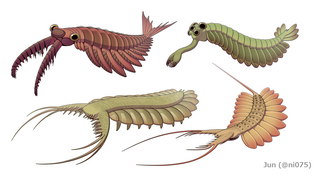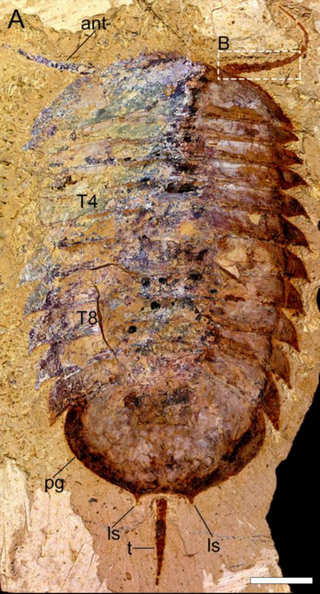
Lobopodians are members of the informal group Lobopodia, or the formally erected phylum Lobopoda Cavalier-Smith (1998). They are panarthropods with stubby legs called lobopods, a term which may also be used as a common name of this group as well. While the definition of lobopodians may differ between literatures, it usually refers to a group of soft-bodied, marine worm-like fossil panarthropods such as Aysheaia and Hallucigenia.

Hallucigenia is a genus of lobopodian, known from Cambrian aged fossils in Burgess Shale-type deposits in Canada and China, and from isolated spines around the world. The generic name reflects the type species' unusual appearance and eccentric history of study; when it was erected as a genus, H. sparsa was reconstructed as an enigmatic animal upside down and back to front. Lobopodians are a grade of Paleozoic panarthropods from which the velvet worms, water bears, and arthropods arose.

Dinocaridida is a proposed fossil taxon of basal arthropods that flourished in the Cambrian period with occasional Ordovician and Devonian records. Characterized by a pair of frontal appendages and series of body flaps, the name of Dinocaridids refers to the suggested role of some of these members as the largest marine predators of their time. Dinocaridids are occasionally referred to as the 'AOPK group' by some literatures, as the group compose of Radiodonta, Opabiniidae, and the "gilled lobopodians" Pambdelurion and Kerygmachelidae. It is most likely paraphyletic, with Kerygmachelidae and Pambdelurion more basal than the clade compose of Opabiniidae, Radiodonta and other arthropods.

Anomalocarididae is an extinct family of Cambrian radiodonts, a group of stem-group arthropods.

Naraoia is a genus of small to average size marine arthropods within the family Naraoiidae, that lived from the early Cambrian to the late Silurian period. The species are characterized by a large alimentary system and sideways oriented antennas.

Parapeytoia is a genus of Cambrian arthropod. The type and only described species is Parapeytoia yunnanensis, lived over 518 million years ago in the Maotianshan shales of Yunnan, China. Unidentified fossils from the same genus also had been discovered from the nearby Wulongqing Formation.

Fuxianhuia is a genus of Lower Cambrian fossil arthropod known from the Chengjiang fauna in China. Its purportedly primitive features have led to its playing a pivotal role in discussions about the euarthropod stem group. Nevertheless, despite being known from many specimens, disputes about its morphology, in particular its head appendages, have made it one of the most controversial of the Chengjiang taxa, and it has been discussed extensively in the context of the arthropod head problem.

Helmetia is an extinct genus of arthropod from the middle Cambrian. Its fossils have been found in the Burgess Shale of Canada and the Jince Formation of the Czech Republic.

Pectocaris is an extinct genus of bivalved arthropods from the Cambrian Maotianshan Shales, Yunnan Province of China. There are currently three known species within the genus.

Radiodonta is an extinct order of stem-group arthropods that was successful worldwide during the Cambrian period. They may be referred to as radiodonts, radiodontans, radiodontids, anomalocarids, or anomalocaridids, although the last two originally refer to the family Anomalocarididae, which previously included all species of this order but is now restricted to only a few species. Radiodonts are distinguished by their distinctive frontal appendages, which are morphologically diverse and used for a variety of functions. Radiodonts included the earliest large predators known, but they also included sediment sifters and filter feeders. Some of the most famous species of radiodonts are the Cambrian taxa Anomalocaris canadensis, Hurdia victoria, Peytoia nathorsti, Titanokorys gainessii, Cambroraster falcatus and Amplectobelua symbrachiata, the Ordovician Aegirocassis benmoulai and the Devonian Schinderhannes bartelsi.

Vetulicola cuneata is a species of extinct animal from the Early Cambrian Chengjiang biota of China. It was described by Hou Xian-guang in 1987 from the Lower Cambrian Chiungchussu Formation, and became the first animal under an eponymous phylum Vetulicolia.

Cucumericrus ("cucumber-leg") is an extinct genus of stem-arthropod. The type and only species is Cucumericrus decoratus, with fossils discovered from the Maotianshan Shales of Yunnan, China.

The Luolishaniidae or Luolishaniida are a group of Cambrian and Ordovician lobopodians with anterior 5 or 6 pairs of setiferous lobopods. Most luolishaniids also have posterior lobopods each with a hooked claws, and thorn-shaped sclerites arranged as three or more per trunk segment. The type genus is based on Luolishania longicruris Hou and Chen, 1989, from the Chengjiang Lagerstatte, South China. They are presumed to have been benthic suspension or filter feeders.

Squamacula is an extinct artiopodan arthropod from the Cambrian Series 2. The type species S. clypeata was described in 1997 from the Chengjiang biota of Yunnan, China. At the time of description there were only two known specimens of S. clypeata, but now there are at least six known specimens. In 2012 a second species S. buckorum was described from the Emu Bay Shale of Australia.

Retifacies abnormalis is an extinct arthropod that lived in the lower Cambrian. Its fossil remains have been found in the Maotianshan Shales of Yunnan, China. It is a member of the Artiopoda, and closely related to Pygmaclypeatus.

Acinocricus is a genus of extinct panarthropod belonging to the group Lobopodia and known from the middle Cambrian Spence Shale of Utah, United States. As a monotypic genus, it has one species Acinocricus stichus. The only lobopodian discovered from the Spence Shale, it was described by Simon Conway Morris and Richard A. Robison in 1988. Owing to the original fragmentary fossils discovered since 1982, it was initially classified as an alga, but later realised to be an animal belonging to Cambrian fauna.
Luolishania is an extinct genus of lobopodian panarthropod and known from the Lower Cambrian Chiungchussu Formation of the Chengjiang County, Yunnan Province, China. A monotypic genus, it contains one species Luolishania longicruris. It was discovered and described by Hou Xian-Guang and Chen Jun-Yuan in 1989. It is one of the superarmoured Cambrian lobopodians suspected to be either an intermediate form in the origin of velvet worms (Onychophora) or basal to at least Tardigrada and Arthropoda. It is the basis of the family name Luolishaniidae, which also include other related lobopods such as Acinocricus, Collinsium, Facivermis, and Ovatiovermis. Along with Microdictyon, it is the first lobopodian fossil discovered from China.

Hallucigeniidae is a family of extinct worms belonging to the group Lobopodia that originated during the Cambrian explosion. It is based on the species Hallucigenia sparsa, the fossil of which was discovered by Charles Doolittle Walcott in 1911 from the Burgess Shale of British Columbia. The name Hallucigenia was created by Simon Conway Morris in 1977, from which the family was erected after discoveries of other hallucigeniid worms from other parts of the world. Classification of these lobopods and their relatives are still controversial, and the family consists of at least four genera.

Lenisambulatrix is a genus of extinct worm belonging to the group Lobopodia and known from the Lower Cambrian Maotianshan shale of China. It is represented by a single species L. humboldti. The incomplete fossil was discovered and described by Qiang Ou and Georg Mayer in 2018. Due to its missing parts, its relationship with other lobopodians is not clear. It shares many structural features with another Cambrian lobopodian Diania cactiformis, a fossil of which was found alongside it.
The Cambrian chordates are an extinct group of animals belonging to the phylum Chordata that lived during the Cambrian, between 538 and 485 million years ago. The first Cambrian chordate known is Pikaia gracilens, a lancelet-like animal from the Burgess Shale in British Columbia, Canada. The discoverer, Charles Doolittle Walcott, described it as a kind of worm (annelid) in 1911, but it was later identified as a chordate. Subsequent discoveries of other Cambrian fossils from the Burgess Shale in 1991, and from the Chengjiang biota of China in 1991, which were later found to be of chordates, several Cambrian chordates are known, with some fossils considered as putative chordates.





















